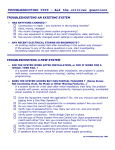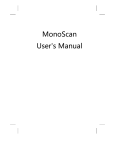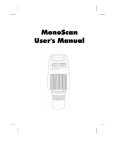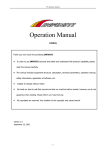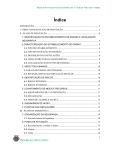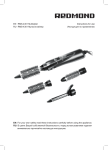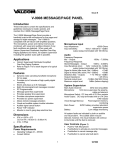Download Manuale Operativo Operating Manual Serie ULG
Transcript
Manuale Operativo Operating Manual Serie ULG Trasmettitori di livello ad ultrasuoni ULG series Ultrasonic level gauge Introduzione Introduction Questo manuale non contiene tutte le informazioni relative ad ogni tipo di apparecchiatura, né prende in considerazione tutti i possibili casi di montaggio, di funzionamento o di manutenzione. Per maggiori informazioni o per problemi particolari non considerati nel manuale Vi preghiamo di rivolgerVi al nostro ufficio tecnico. La garanzia é quella prevista nelle ns. condizioni generali di assistenza. Tale garanzia non viene né ampliata né limitata da quanto contenuto in questo manuale. This manual does not contain information concerning all type of transmitters or all different installation and/or working and mounting solutions. For more information or for particular problems not considered in this manual, please address to our technical office. The warranty period is the one contemplated in our general servicing conditions. This warranty is neither increased nor restricted by the contents of this manual. Attenzione! Attention! Questo strumento deve essere installato ed utilizzato solo da personale qualificato che abbia precedentemente verificato la correttezza della alimentazione in modo che sia in funzionamento normale, sia in caso di guasto dell'impianto o di sue parti nessuna tensione pericolosa possa arrivare all'apparecchiatura. Poiché lo strumento può essere utilizzato sia con alte pressioni sia con sostanze aggressive va tenuto presente che un uso non corretto può portare danni gravi a persone e cose. Un funzionamento corretto e sicuro presuppone un adeguato trasporto, immagazzinamento e montaggio nonché una manutenzione appropriata. E' pertanto necessario affidare l'apparecchiatura a persone che abbiano esperienza con il montaggio, la messa in servizio ed il funzionamento e che siano in possesso dei titoli per svolgere la loro attività con riferimento agli "Standard di Sicurezza". This instrument has to be installed and used only by qualified persons who have first checked the correctness of supply voltage so that both in standard working conditions and in presence of damages of the plant or of any part of it, no dangerous voltage can reach the instrument. As the instrument can be utilized both with high pressure values and with aggressive media it must be considered that an incorrect use of it could bring even serious damages to people and things. A correct and safe working needs an adequate transport, stock and mounting other than an appropriate maintenance service. So it is necessary for the people handling these apparatus to have knowledge and experience in mounting, servicing and working and to have title to do their job with reference to “Safety Standards“. La Società si riserva il diritto di modificare il contenuto di questo manuale senza preavviso. The Company could modify this manual in any moment without previous advice. Rev Data/Date Descrizione/Description Red Chk App 0 26/01/09 Emissione MC RS EV Chapter 1 Introducing ULG ULG is an ultrasonic, continuous-level measurement gauge of mono-block construction (combining the sensor and electronic components in a single unit). ULG measures the height of both liquids and solids accurately. It can be used for the following measurement tasks: ) Liquid tanks with calm surfaces ) Solids tanks that are dust-free ) Open channel flow measurement ULG has a range of up to 15 m (49.21 ft) with an accuracy of 0.25% within that range. The following diagrams show the front and side views of ULG, and its dimensions: Figure 1: Front View Figure 2: Side View Specifications Accuracy 0.25% of measuring range Resolution 1 mm (0.04") Beam angle 5° @ 3db point Ambient temperature compensation Automatic Measuring Ranges Liquids Solids Open channels Short Range 0.25 m — 5 m 0.82 ft — 16.4 ft Standard 0.6 m — 15 m 1.96 ft — 49.2 ft Short Range 0.25 m — 5 m 0.82 ft — 16.4 ft Standard 0.6 m — 8.5 m 1.96 ft — 27.8 ft Short Range 0.25 m — 5 m 0.82 ft — 16.4 ft Standard 0.6 m — 15 m 1.96 ft — 49.2 ft Mechanical Specifications Enclosure IP 65, Mono-block construction. Plastic enclosure: ABS+UV Pollution degree 2 (as per IEC61010) Insulation category II (as per IEC61010) Wetted parts Sensor body: PolyProp. PVDF, Coated aluminum (ECTFE) for Solid/Liquid model. Operating temperature -40° C to + 70° C (-40° F to +158° F) Mounting 2" BSP or 2" NPT Operating pressure 0.9 bar Dimensions 289 x 107 x 85 mm (11.38 x 4.21 x 3.35") Weight Up to 1.4 kg (3.08 lb) Electrical Specifications Display Integral LCD, four digits. Loop current 4 — 20 mA, 750 Ω @ 28 VDC Supply 12 — 28 VDC (CE certified) Sensor Recommendations Material Description Coated Aluminum (Halar®ECTFE) Designed for complex environments with problematic echoes, such as non-conductive vapors, solids or liquids. Good performance in problematic applications. Usable in highly acidic or alcoholic environments. High sensitivity to echoes. Chapter 2 Installing ULG Precautions ) Ensure that ULG is mounted in an area that meets the stated temperature, pressure and technical specifications. ) Ensure that high-voltage sources or cables are at least 1 m away from the sensor and its cable. ) Use round cables with minimum diameter of 6 - 7 mm to ensure that the unit remains sealed, IP 65. ) Ensure that cables are routed correctly and tightened along walls or pipes. ) Installation and operation of this product should be performed, according to the Product User Manual and Product Certification. Otherwise the use of this product is prohibited. Installing When installing, ensure that it is: ) Mounted above the dead-zone area. NOTE: If the device enters the blocking distance (dead zone), it will not measure correctly. ) Positioned at least 0.5 m (1.64 ft) away from the tank walls. ) Perpendicular to the surface of the target. NOTE: Even the slightest difference in angle may affect echo quality. ) Placed as far as possible from noisy areas, such as a filling inlet. NOTE: When installed in a humid environment it is recommended to position the sensor on a tripod on top of the vessel. Installing on Threaded Flange/Thread-Free Flange ULG is available in two thread types, 2" BSP or 2" NPT. ULG can be installed with threaded-flange mounting or with thread-free flange mounting, as shown below: Figure 3: Threaded Flange/Thread-Free Flange Mounting NOTES: When installing a thread-free flange mounted unit, you will need a 2" locking nut to secure the unit inside the tank. When installing a threaded flange, ensure that it matches the ULG threads. ¾ To install: 1 Insert the threaded end of ULG into the aperture at the top of the tank or pipe. 2 Bolt ULG into place in one of the following ways: ) Threaded-flange mounting: Screw the unit into a flange with a threaded 2" hole. ) Thread-free mounting: Place ULG in the flange, and bolt it from within the tank with a 2" locking nut. Installing ULG via Extension Pipes If the level of the measured surface falls within the dead-zone area, you should use an extension pipe to mount ULG. When using an extension pipe, ensure that: ) The sensor is positioned in the center of the pipe. ) The pipe extension is parallel to the side/tank walls. ) The internal pipe diameter is at least 3" wide. When installing the ULG with extension pipes, follow these specifications: Pipe Length Internal Pipe Diameter 0.50 m (1.64 ft) 3" NOTE: It is always recommended to use interference signal feature (Pr.03) to locate interfering signals when using an extension pipe. Connecting the ULG to a Power Cable Using a connector 1 Remove the retaining screw from the electrical connector. 2 Remove the male part. 3 Separate the plastic electrical connector shell from the wiring block. 4 Connect the +24V wire to Terminal 1, connect the -24V wire to Terminal 2 on the Wiring Block. 5 Snap the electrical connector wiring block back into the electrical connector shell. 6 Pull the electrical connector to the socket plug and fasten with the retaining screw provided. Figure 4: Connector Front View NOTE: The cable for the mating connector must be at least 6 mm in diameter. Using a conduit 1 Remove the four retaining screws from the conduit adapter cover. 2 Pull the electrical wires through the 1/2" NPT/ M20 conduit connection. 3 Connect the -24V wire to Terminal 1, connect the +24V wire to Terminal 2 on the Wiring Block. 4 Return the adapter’s cover to its place properly. Make sure that the O-ring is placed correctly. Fasten the four retaining screws. Figure 5: Conduit Adapter NOTE: The conduit adapter should not exceed a torque of 50 lb/In. To maintain the transmitter properly sealed, make sure that conduit is firmly screwed to the conduit's adaptor. Non-Intrinsically Safe Connections Figure 6: Non-Intrinsically Safe Positive Ground Connection Figure 7: Non-Intrinsically Safe Negative Ground Connection Power Supply and Load Resistance Recommendations The following table specifies the recommended resistance range for each power supply voltage (Non-Intrinsically Safe). Power Supply Voltage Minimum Current on Resistor Maximum Current on Resistor 12 V 0Ω 50 Ω 15 V 0Ω 220 Ω 24 V 41 Ω 610 Ω 28 V 68 Ω 820 Ω Ripple/Noise Parameters Recommended for the Power Supply The following ripple/noise parameters are recommended for the power supply: ) For less than 15 V: 75 mV p-p max ) For more than 15 V: 100 mV p-p max Chapter 3 Setting Up and Calibrating ULG This chapter explains how to set up and calibrate ULG for accurate measurement monitoring. ULG is supplied with preprogrammed default settings, making it ready for immediate operation. There is no need to change the default settings, unless you wish to calibrate ULG for your specific requirements; however, it is recommended that you replace the default tank height value with the actual tank height. When using, the tank height is calculated as the distance from the surface of the sensor to the bottom of the tank. You should enter this value whenever tank height is required. (For flow measurement, enter the precise flume height.) ULG contains eleven programs, referred to as functions, which enable you to change the default settings and calibrate ULG as required. These functions are accessed from a functions menu. The functions Pr01, Pr02, Pr04 and Pr05 are the most important to ensure correct usage of your ULG device (with the addition of Pr00 if using a ULG O model). Function Pr03 may be used if there are interfering signals. The remaining functions (Pr06, Pr07, Pr08, Pr09 and Pr10) enable you to customize ULG for your monitoring requirements or to restore factory default settings. NOTE: Some functions are only relevant for particular ULG models. The diagram below shows the functions available in the functions menus: Figure 10: Functions Menus Using Functions The LCD display screen, functioning in "normal" mode, provides continuously updated measurement readings. The display screen is also used to view menu options, function settings and data values, accessed by using the function buttons. The picture below shows the upper part of ULG: LCD display Next button Enter button Back button Escape button Figure 11: Display and Function Buttons The function buttons are used to perform various operations, summarized in the following table. Button Uses Include: ) Accessing the functions menu (when pressed simultaneously with ) ) Selecting functions ) Progressing to the next step of a function ) Moving from left to right between displayed digits (see note on the following page) ) Saving changes to data ) Accessing the functions menu (when pressed simultaneously with ) ) Exiting the functions menu to restore the distance reading ) Moving from right to left between displayed digits (see note on following page) ) Exiting a function without saving changes ) Clearing error messages ) Scrolling through the functions menu or ) Scrolling through available data values in functions ) NEXT button only: Recording interfering signals ) NOTE: Within some functions, the digits in the displayed value can be individually modified. This is indicated by a flashing digit (flashing digits are shown in gray in the display illustrations, for example, ). In this case, the ENT and ESC buttons enable you to move between the digits. Each flashing digit can be modified using the BACK and NEXT buttons. ¾ To start up and access the functions: Press/Action > Connect ULG to power supply > After a brief pause > and (simultaneously) > or > Display Explanation Temporary display while ULG takes a reading. For example: Distance reading. For example: Enters the functions menu. Used to search for the required menu selection. Accesses the selected function. NOTES: If an error message the main menu. appears, press the ESC button to return to Values are displayed in meters and centimeters or feet and inches, according to the version. Resetting ULG The PR01 function enables you to do a reset, refreshing the ULG measurement reading. (Other saved function settings are not changed.) After resetting, the actual reading is displayed on the LCD, and ULG begins to scan (same as in turning the unit on/off). The reset function may sometimes be required after changing one of the ULG settings or after receiving an error message. NOTE: During reset the ULG will display 8.8.8.8 followed by 22mA current output. ¾ To reset: Press/Action > Display Required menu selection. and (simultaneously) > > > Explanation Temporary display while ULG takes reading. After a brief pause and (simultaneously) For example, Distance reading. Returns to the functions menu. Entering the Tank Height Value The Pr02 function enables you to enter the tank height. The default value is the highest value in the relevant measurement range for your model. If you enter a value that exceeds this highest value, the Err error message is displayed and the value is not saved. NOTES: Whenever the tank height is required, you should enter the distance from the surface of the sensors to the bottom of the tank. For flow measurement, enter the precise distance from the sensor to the bottom of the flume (the deepest point between the flume and sensor). The first digit can be modified to read between 0 and 1 for metric units or between 0 and 5 for feet units. For Shift Blocking Distance refer to Chapter 3, page 46 . ¾ To enter the tank height value: Press/Action Display Explanation > Required menu selection. > Indicates the measurement unit, either meters or feet. > For example > or Displays last saved tank height or default value (maximum value in range). Used to enter a new value or > To save the new value, OR > when standing press on the far-right digit. After YES is displayed, the display returns to the functions menu. To return to the main menu without saving, when standing press on the far-left digit. Defining Interfering Signals The Pr03 function enables you to locate and store up to six interfering signals (false echoes) in the memory, to avoid having obstructions such as a tank agitator or sidewall interfere with the measurement of the contents. Defining interfering signals is done while the tank is empty. Echo amplitude Memory stored interferences (up to 4) Real echo Distance Figure 12: Scan Distance Process Each reading (scan distance) taken using the Pr03 function is stored as an interfering signal, until a reading is achieved that indicates the real echo. If six interfering signals are already stored, the following values will not be saved. NOTES: The reading of the actual target height may not be exact, for example, a target height of 6 m may give a reading in the range 5.98 - 6.02. The displayed values are in distance units. ¾ To define interfering signals: Press/Action Display > Required menu selection. > Select Search to locate acoustic interferences, or Clear to delete stored interferences. or > Displayed after the selection for 3 seconds and then the menu returns to Pr.03. > > > Explanation Temporary display while ULG searches for interfering signals. After a brief pause For example, Depth to interfering signal. Saves the interfering signal, then searches again and displays the next reading. Continue to press this button to save up to six Press/Action Display Explanation interference readings. > > For example, Actual target height reading indicates that there are no more interfering signals. Saves the entered values. NOTES: If the value represents an interference or false echo or false target press NEXT. If the value represents the real target, real distance – press ENT. Configuring 4mA Current Output Pr04 function enables you to enter values to be used as the 4mA mark for remote monitoring. You can define the 4mA values for Level, Distance or Flow measurements. The measurement values types should be defined in Pr.04 (described on page 31). These definitions will be applicable as well for the 20mA values defined in Pr.05. Distance and level measurements can be defined for both Solid and Liquid models. For Flow models, distance, level and flow measurements can be defined. To set 4mA and 20mA for level measurements you should configure Pr04 and Pr05 for level values. For example, if we measure a tank with tank height configured for 5 meters, the 4mA values will represent zero tank level and 20mA values will represent full tank level. Therefore, the value entered in Pr04 will be 0.000m and the value entered in Pr05 will be 5.000m. When setting 4mA and 20mA for distance measurements, 4mA values will represent the minimal distance between the surface of the target and the sensor and 20mA values will represent the maximal distance between the sensor and the surface of the target. Therefore, 4mA represents the full part of the tank and 20mA represents the empty part of the tank. ¾ To enter 4mA values: Press/Action Display > Explanation Required menu selection. > For example, Select 4mA (and 20mA) values format: Level (L000), Distance (d000) and Flow (F000). For example Last saved 4mA level or zero default value. or > > > Used to enter a new value or or Press/Action > Display Explanation To save the new value, when standing press on the far-right digit. After YES is displayed, the display returns to the functions menu. > To return to the main menu without saving, when standing press on the far-left digit. Configuring 20mA Current Output The Pr05 function enables you to enter values to be used as the 20mA mark for remote monitoring. ¾ To enter 20mA values: Press/Action Display > Explanation Required menu selection. > > For example > or Last saved 20mA level or default value (maximum value in range). Used to enter a new value, as described on page 26. or > To save the new value, OR when standing press on the far-right digit. After YES is displayed, the display returns to the functions menu. Press/Action > Display Explanation To return to the main menu without saving, press when standing on the far-left digit. NOTES: Type of measurement (level, distance, flow) selected in Pr.04 is also applicable for Pr.05. The values for 4mA and 20mA must be different; otherwise an Err error message is displayed. The values for 4mA and 20mA should not be higher than the value used for the tank height (Pr02). The first digit of the 20mA value can be modified to read between 0 and 1 for metric units or between 0 and 5 for U.S. Standard units. After accessing the Pr05 function, the unit generates a fixed current of 22mA on the 4-20mA line. When the ULG reverts to regular scanning mode, the 4-20mA line returns to regular functioning. Please refer to chapter 5 Troubleshooting for 20mA error indications. Selecting Low/High Dynamic Speed (Open Channels and Liquid Only) The Pr06 function enables you to choose the required speed level. There are two settings available: ) SE 0: Low dynamic mode (default setting). This mode provides slower readings with a greater degree of accuracy (Rate of up to 80 cm/31in per min’). ) Fail Safe: 10 minutes. ) SE 1: High dynamic mode. This mode provides faster readings but with less precision (Rate of up to 100 cm/39 in per min’). ) Fail Safe: 3 minutes. NOTE: Fail – Safe timer determines the waiting period from an echo loss till a transmission of an error signal. ¾ To select the speed mode: Press/Action Display Explanation > Required menu selection. > Displays the current operation mode setting. or > Used to toggle between the operation modes. or > Saves the selected operation mode. Defining Working Area The Pr07 function allows you to add distance range that exceeds the tank’s height, thus enabling accurate readings of complicated tank shapes with conic ending. This may be required when the vessel has a conical bottom shape which is causing false echoes and consequently faulty measurements. The minimal value can be the entered tank height and the maximal value can be double the value of the entered tank height (limited to 15m/49ft). The default setting is the entered tank height. Figure 13: Defining Working Area NOTE: It is recommended to use the Pr.07 function only in Distance mode. ¾ To define a Working Area: Press/Action Display Explanation > Required menu selection. > Displayed when entering the function. > > for example: or Displays the value last saved in the tank height (default). The entered value should not be more than double the tank height and should not exceed the ULG maximum measuring range (15m/49ft). Used to enter a new value, as described on page 26. or > Saves the entered value. Press/Action > Display Explanation Used to move on to the next function. or Selecting Distance or Level Display The Pr08 function enables you to choose whether ULG displays either distance or level measurements. There are two settings available: ) d000: Distance mode (default setting): In this mode, ULG displays the distance from the sensor to the surface of the contents. ) L000: Level mode: In this mode, ULG displays the level of the contents from the bottom of the tank. NOTE: The measurement mode selected for the display will not influence the measurement mode selected for the 4-20mA values (Pr.04). ¾ To select distance or level display: Press/Action Display Explanation > Required menu selection. > Displays the current distance/level mode setting. or > Used to toggle between the modes. or > Saves the selected mode. Entering factor for Gas Compensation Function Pr.09 enables you to compensate for sound velocity changes in different types of gasses. You can enter the appropriate factor for each type of gas listed on the ‘Gas Factor Table’ (Appendix A). For example the sound velocity in air (in room temperature) is 343 m/sec and for Methane (Ch4) 445.82 m/sec, therefore a factor of 445.82/343 = 1.29 should be entered to compensate for this type of gas. This factor will compensate in cases when the gas compound consists on 100% Methane. In case the gas is not pure, the sound velocity cannot be estimated and therefore a minor deviation could appear. It is recommended to use a reference measurement indicator (using a tape or other measuring device) and compare the measurement results between the ULG and the reference measurement indicator. If the result is correct, press ENT. If the accuracy deviation is higher than expected, continue and calibrate the factor to meet the gas maintained in the vessel. For example, if the gas composition consists of water and gas you can add +/- 0.01 to the factor figure already entered, to meet your application requirements. ¾ To enter a gas compensation factor: Press/Action Display Explanation > Required menu selection. > Default screen. > Default value. > Choose a factor from the ’Gas Factor Table’ (Appendix A, Page 75). or or For example: > This is the factor for Ethanol. Saves the chosen gas factor. NOTES: Repeat this procedure if the measurement results differ from the actual material level measured with a reference tape (or other reference measurement method). Add or reduce 0.01 to calibrate the factor figure already entered. Updated on-screen results may take a few seconds to appear. Restoring the Default Settings The Pr10 function allows clearing all user-defined settings and reverting to the default factory settings. Default factory settings are: Pr.00: GPM 1U01 or M /Hr 1E01 Pr.02: Sbd 00.00, E000, Tank Height =default Pr.03: Resets all interfering signals Pr.04: Solid/Liquid device L000, 00.00 or Flow device F000, 00.00 Pr.05: Solid/Liquid device Tank Height = Pr.02 Flow device 55500 M³/Hr or 244400 GPM Pr.06: SE 0 (Liquid & Flow) Pr.07: Tank Height = Pr.02 Pr.08: d000 Pr.09: 01.00 NOTE: If you decide not to revert to the default settings, press ESC when CLCL is displayed. A redo option is not available when ENT has been pressed. ¾ To restore the default settings: Press/Action > Display Explanation Required menu selection. > > Reverts all settings to default factory settings. Shifting the Blocking Distance This function enables you to define an area in which measurement results would be ignored. This option is applicable for installations requiring extension pipes or nuzzles positioned above the material level. This area should fit the pipe/nuzzle length to eliminate false echoes and to provide accurate and stable measurement readings. ¾ To shift the blocking distance: Follow the directions given for Entering the Tank Height Value, page 26. Instead of entering the tank height value, enter 00.01, and continue as follows: Press/Action Display Explanation > Insert this code to enter the Blocking Distance area. > This message will flash for a few seconds, indicating an entry to the Blocking Distance area. > For example, or Shifts the blocking distance to 0.75m (2.46 ft). or > Saves this entry and returns to Pr.02. NOTES: Shifting of the Blocking Distance is limited to 1.5m/4.9ft. The value entered to the Sbd incorporates the Dead Zone Value. Pr.10 (Clear) reverts the blocking distance to its default. Echo received from the defined Blocking Distance area will be ignored by the ULG and the measurement result will be based on the next echo. When installing via extension pipe add approx. 15 cm (5.9 in) to the SBD length (i.e. the extension pipe length). Make sure that this addition would not overlap with the maximal height of substance being measured. Verifying the Version Number In addition to the functions described, you can verify the ULG version number. ¾ To verify the version number: Follow the directions given for Entering the Tank Height Value, page 26. Instead of entering the tank height value, enter 00.17, and continue as follows: Press/Action Display Explanation > > > After a brief pause Displays the version number. Defining 22mA Signal Error Messages ULG allows you to define if the following signal error indications: Near Zone and Lost Echo, will be active when the current output reaches 22mA. The ULG default setting enables 22mA analog current and error messages to appear on its LCD display. Near Zone - whenever the distance is below the defined Dead Zone (depending on the ULG model you are using) message will be displayed on the LCD. Lost Echo - whenever the echo is lost, or in cases when the measurement results exceed the tank height or when a returned echo is not received displayed on the ULG’s LCD. message will be You can choose to enable or disable these error messages and 22mA analog signal as follows: ) d000: Disable ) E000: Enable (default setting) ¾ To disable/enable 22mA signal error: Follow the directions given for Entering the Tank Height Value, page 26. Instead of entering the tank height value, enter 00.16, and continue as follows: Press/Action Display Explanation > Choose disable > Used to toggle between the modes. or Disables the 22mA error messages Chapter 4 Troubleshooting ULG This chapter describes how to resolve problems that may occur when calibrating ULG, as follows: Error Description Solution Noise in area. Check that the power supply is appropriate. Faulty power supply. Make sure that the power supply corresponds with the specifications described in Chapter 2, Installing UIG . If the problem persists, replace the power supply. Sensor disconnected. Contact the distributor for further instructions. Any combination of three 8s and one 1: Indicates an electrical shortage caused by depressing the buttons for too long. Contact the manufacturer for further instructions. Error Description Solution Appears for several seconds after restarting the unit. If it is displayed for more than several seconds, it may be due to one of the following: Make sure that the power supply corresponds with the specifications described in Chapter 2, Installing UIG . If the problem persists, replace the power supply. ) Power supply voltage is too low ) Load resistor resistance is too high or unnecessary ) A random pulse that causes the unit to automatically restart Measurement value is greater than 9999. Double check the unit configuration (Tank h, type of flume, 4-20mA settings.) In Flow mode, appears when Decrease the Tank Height the entered tank height is value. incorrect. 22mA Signal Error Messages The following list of messages will appear on the display and coincides with a 22mA analog current error output signal (when the error signals messages are enables): Error Description Solution Sensor disconnected. Contact the distributor for further instructions. Near dead zone. (depends on the measurement definitions) Move the sensor farther from the dead zone area. Tank empty. (depends on the measurement definitions) Check the level of material in the tank. Noise in area. (indicated by 22mA if the Error Signals are Enabled). Check that the power supply is appropriate. Faulty power supply. (indicated by 22mA if the Error Signals are Enabled). Make sure that the power supply corresponds with the specifications described in Chapter 2, Installing UIG . If the problem persists, replace the power supply. Appendix A Gas Factor The following table contains 33 different types of gasses and their factor for compensating the sound velocity: Gas Symbol Factor Acetic Acid C2h4o2 0.62 Acetone C3h6o 0.63 Acetaldehyde C2h4o 0.74 Acetyl Chloride C2h3c1o 0.54 Acetylene C2h2 0.99 Ammonia H3n 1.26 Argon Ar 0.92 Benzene C6H6 0.53 Bromine Br2 0.41 Bromochlorodifluoromrthane Cbrclf2 0.37 Butanone CH3COCH2CH3 0.56 Gas Symbol Factor Carbon Dioxide CO2 0.77 Carbon Monoxide CO 1.01 Carbon Tetrachloride CCI4 0.38 Chlorine Cl2 0.68 Dimethyl Ether C2h6o 0.71 Ethane C2h6 0.90 Ethanol C2h6o 0.71 Ethylene C2h4 0.95 Helium He 2.93 Hydrogen H2 3.79 Hydrogen Sulfide H2S 0.89 Isopropyl Alcohol C3h8o 0.62 Methane CH4 1.29 Methyl Hydrazine Ch6n2 0.71 Neon Ne 1.30 Nitrogen N2 1.01 Gas Symbol Factor Nitromethane CH3NO2 0.63 Oxygen O2 1.02 Propane C3H8 0.72 Propanol C3H8O 0.61 Tetrahydrofuran C4H8O 0.57 Condizioni generali di garanzia 1. GARANZIA Gli strumenti forniti da VALCOM® S.r.l. sono coperti da garanzia, su difetti di produzione, valida 12 mesi dalla messa in marcia, ma non oltre 18 mesi dalla data di spedizione; la garanzia non copre prodotti che risultino manomessi, riparati da terzi non autorizzati o utilizzati in modo non conforme alle avvertenze di utilizzazione. Anche se non espressamente pattuito, la merce resa franco destino, viaggia a rischio e pericolo del committente. 2. SERVIZI DI ASSISTENZA Durante il periodo di assistenza in garanzia, VALCOM® S.r.l. riparerà, a propria discrezione, i prodotti o sostituirà strumenti difettosi con pezzi nuovi. Se, dopo ripetuti sforzi, VALCOM® S.r.l. non si dimostrerà in grado di riportare il prodotto ad un buon livello di funzionamento, essa potrà, a sua discrezione, rimborsare il prezzo di acquisto o sostituire il prodotto con un nuovo avente le stesse caratteristiche. 3. ESCLUSIONI Sono esclusi dai servizi di assistenza in garanzia: 3.1. strumenti soggetti ad usura; 3.2. difetti risultanti da normale usura; 3.3. difetti risultanti da operazioni che non rientrano nei parametri d’uso descritti nei manuali d’uso; 3.4. difetti risultanti dal mancato rispetto delle avvertenze generiche; 3.5. difetti risultanti da applicazione/prelievo di segnali fuori dai massimi limiti ammessi; 3.6. malfunzionamento causato da danni (anche se accidentali). 4. RESPONSABILITA’ L’utente non ha altre rivendicazioni di garanzia o di risarcimento verso VALCOM® S.r.l. che quelle poste in questo documento. VALCOM® S.r.l. non è responsabile per danni incidentali o consequenziali di qualsiasi natura e forma, né di alcun tipo di costo aggiuntivo da parte di chiunque per i prodotti ceduti al committente. VALCOM® S.r.l. non sarà responsabile per alcun danno provocato anche per negligenza durante le riparazioni. VALCOM® S.r.l. e i suoi tecnici di assistenza non saranno responsabili né per danni né per la perdita di eventuali programmazioni introdotte negli strumenti inviati per assistenza. 5. COSTI La riparazione degli strumenti viene effettuata franco stabilimento VALCOM® Srl di Terranova P. (LO). Gli strumenti riparati verranno ritornati in porto assegnato (i rischi di trasferimento e gli oneri sono a carico dell’acquirente). Gli strumenti spediti per assistenza in garanzia che dovessero risultare correttamente funzionanti verranno aggravati di un costo di Euro 50,00 per spese di controllo e gestione. Gli strumenti non coperti da garanzia verranno verificati tecnicamente; la valutazione dei costi verrà formalizzata e trasmessa al Cliente attraverso la conferma di Riparazione (Mod.CDR). In caso di mancata accettazione del preventivo gli strumenti subiranno un aggravio da un minimo di Euro 50,00 ad un massimo di Euro 250,00 a seconda del tipo di apparecchio, per spese di controllo, verifica tecnica e gestione. General servicing conditions 1. WARRANTY Instruments supplied by VALCOM® S.r.l. are covered by warranty, against production faults, for a period of 12 months from start up to a maximum of 18 months from the original shipping date; warranty does not cover products being damaged, repaired by not authorized servicing or handled not in accordance with suggested on standard warnings. Even if not expressly agreed, goods always travel at buyer’s total risk and charge. 2. SERVICING During period of servicing covered by warranty, VALCOM® S.r.l. will repair, at his own discretion, products or will replace defective instruments with new units. If, after several efforts, VALCOM® S.r.l. will not be able to bring the instruments to a good functioning level, the company itself could, at his own discretion, pay back purchase price or replace the product with a new one, having same characteristics. 3. EXCLUSIONS VALCOM® S.r.l. warranty servicing does not cover: 3.1. instruments suffering deterioration; 3.2. defects caused by normal deterioration; 3.3. defects caused by operations not in accordance to working parameters described in operative manual; 3.4. defects caused by not respect of generic warnings; 3.5. defects caused by application/taking of signal out of max limits admitted; 3.6. malfunctioning caused by damages (even if accidental). 4. RESPONSABILITY User can claim against VALCOM® S.r.l. only warranty or compensation conditions stated in this document. VALCOM® S.r.l. is not responsible of any kind of incidental or consequential damage and is not responsible of any additional cost claimed by anybody for products delivered to the customer. VALCOM® S.r.l. is not responsible of any damage caused also by negligence during repairs. VALCOM® S.r.l. and his servicing technicians are not responsible of damages neither for lost of eventual programs introduced in instruments sent for servicing. 5. COSTS Instruments for repair have to be shipped carriage free VALCOM® Srl factory of Terranova P. (LO). Instruments repaired will be returned Fob VALCOM® factory (goods travel at buyer’s total risk and charge). Instruments sent for servicing under warranty, which should appear correctly functioning, will be charged with a cost of Euro 50,00 for checking and management cost. Instruments not covered by warranty will be technically verified; evaluation costs will be formalized and sent to the Client by Repair Acknowledgement (Form “Mod.CDR”). In case of non acceptance of quotation, instruments will be charged with a cost of min Euro 50,00 up to a max of Euro 250,00 depending on type of apparatus, for checking, technical test and management. 6. MODALITA’ OPERATIVE DI ASSISTENZA 6.1. Modulo NAR Procedere all’imballo e alla spedizione del materiale in porto franco. Il materiale deve essere accompagnato dal documento di trasporto. Al ricevimento della merce, VALCOM® Srl assegnerà un numero di identificazione al reso (numero NAR) e lo comunicherà al cliente. Nel caso gli strumenti siano venuti in contatto con sostanze tossiche e/o nocive, ciò deve essere comunicato tempestivamente alla VALCOM® Srl, al fine di tutelare il personale tecnico addetto alla riparazione. 6.2. Solleciti Eventuali solleciti dovranno essere riferiti al numero NAR. 7. CONTROVERSIE Qualsiasi controversia dovesse insorgere tra Fornitore e Cliente, sarà devoluta in via esclusiva alla competenza del Foro di Milano, con rinuncia espressa a qualsiasi altra sede di competenza, anche in caso di chiamate in garanzia, di connessione o continenza di causa. 6. SERVICING OPERATING MODALITIES 6.1. Form “Modulo NAR” Proceed with packing and shipping of material to VALCOM® S.r.l. factory, prepaying shipment costs. Goods must be accompanied by delivery note. At receipt of the goods, VALCOM® Srl will assign an identification number to the return (NAR number) and will communicate it to the customer. If necessary, return NAR form to VALCOM Srl with additional information. If instruments have been exposed to toxic and/or dangerous substances, VALCOM® Srl has to be informed promptly, in order to protect personnel responsible for the repair. 6.2. Reminders Eventual reminders should be referred to NAR number. 7. CONTROVERSY Any controversy arising between Supplier and Customer must be held exclusively in the Forum of Milan, with expressed renunciation to any other Forum of competence, even if in case of warranty claim, connection or contingency of cause.






















































